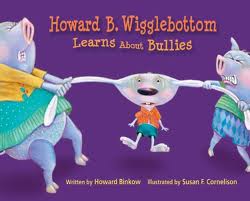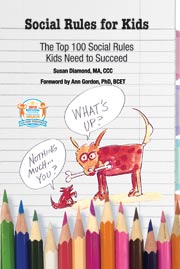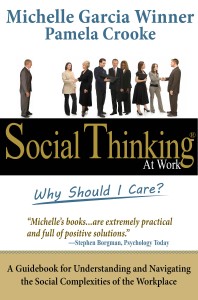
Four Book Suggestions to Develop Social Skills and not be Bullied
During the month of October, families, teachers, other caregivers, and whole communities join forces to bring awareness on the devastating, long lasting effects bullying has on individuals. Victims of bullying can be young children, tweens, teens, and even adults. I have a book suggestion for each age group that will help these individuals develop the Social Skills they need to make and keep good friends and how to to be one.
During National Bullying Prevention Month, communities nationwide work together through events, activities and education to raise awareness of bullying. The End of Bullying Begins with Me is the message organizers of National Bullying Prevention Month want to instill in others.
It is believed that more than 160,000 U.S. students stay home from school each day from fear of being bullied. One in every three students will experience bullying this year. As we have witnessed in Canada this past year, bullied teens have taken their lives when the relentless, heartless bullies used social media to inflict more pain.
With education and awareness sessions there is hope that the potential bystanders or the silent majority who witness bullying taking place will speak up. Bullying has to be addressed throughout the year. Parents and teachers play an important role to educate, empower, and engage youths in discussions about bullying and its effects. I recommend the following books to help in our battle against bullying and how to be a good friend or co-worker at school or in the workplace.
For young children
Howard B. Wigglebottom Learns About Bullies
 by Howard Binkow with illustrations by Susan F. Cornelison
In this book, Howard, the rabbit, has such bullying problems he cannot fall asleep. A little voice in his head kept repeating, “Be Brave, Be Bold, a teacher must be told.” He was afraid if he told he would be called a tattletale or a snitch. For a long week, Howard used his own tactics to stop the Snorton Twins from bullying him. Nothing worked! The Fist-Punching, Name-Calling, Worm-Whipping, Tongue-Wagging, Foot-Stomping bullying continued. Finally he figured the voice in his head had been right all along. He told his teacher who set things in motion to stop the bullies.
Parents and caregivers can use the suggestions at the end on the “Lessons and Reflections” pages to start discussions about bullying. The author explains the different ways a child can be bullied. He wants children to know, “Telling is not wrong or bad. It’s the best thing to do! Be SMART, BRAVE and SAFE. Tell a teacher right away.” There are even ideas to encourage children on how to report bullying.
At the end of the book, to help make our schools safer, teachers, parents, and therapists are invited to share what they do to prevent bullying. These tips will be posted on the existing list of bully resources on their website: www.wedolistem.com
Features Found on We Do Listen Web Site:
by Howard Binkow with illustrations by Susan F. Cornelison
In this book, Howard, the rabbit, has such bullying problems he cannot fall asleep. A little voice in his head kept repeating, “Be Brave, Be Bold, a teacher must be told.” He was afraid if he told he would be called a tattletale or a snitch. For a long week, Howard used his own tactics to stop the Snorton Twins from bullying him. Nothing worked! The Fist-Punching, Name-Calling, Worm-Whipping, Tongue-Wagging, Foot-Stomping bullying continued. Finally he figured the voice in his head had been right all along. He told his teacher who set things in motion to stop the bullies.
Parents and caregivers can use the suggestions at the end on the “Lessons and Reflections” pages to start discussions about bullying. The author explains the different ways a child can be bullied. He wants children to know, “Telling is not wrong or bad. It’s the best thing to do! Be SMART, BRAVE and SAFE. Tell a teacher right away.” There are even ideas to encourage children on how to report bullying.
At the end of the book, to help make our schools safer, teachers, parents, and therapists are invited to share what they do to prevent bullying. These tips will be posted on the existing list of bully resources on their website: www.wedolistem.com
Features Found on We Do Listen Web Site:
- Listen to the Be Brave, Be Bold Song.
- Print bullying guidelines, resources, lessons and posters.
- Enjoy free animated books, games, activities and E Cards.
- Email the author.
Slime & All
An early chapter book on accepting differences – Slime & All by Janet Ann Collins Slime & All is written at second grade reading level, but children four to eight years old will enjoy the story being read. It’s about a giant, slimy worm named Lump who is lonely. Everyone is afraid of him because he’s different. But eventually Lump meets a boy who becomes his friend and introduces him to other kids. This book will encourage children to befriend others who are different from themselves, such as those with special needs.
There’s a similarity to the way the worm is shunned in the beginning and the way some people with special needs are treated. Yes, books about being shunned, which is a very hurtful way to bully others, is a topic our children with different needs must know about and learn to handle.
Read the complete review of Slime & All
Slime & All is written at second grade reading level, but children four to eight years old will enjoy the story being read. It’s about a giant, slimy worm named Lump who is lonely. Everyone is afraid of him because he’s different. But eventually Lump meets a boy who becomes his friend and introduces him to other kids. This book will encourage children to befriend others who are different from themselves, such as those with special needs.
There’s a similarity to the way the worm is shunned in the beginning and the way some people with special needs are treated. Yes, books about being shunned, which is a very hurtful way to bully others, is a topic our children with different needs must know about and learn to handle.
Read the complete review of Slime & All
For Teens and Tweens
Social Rules for Kids -The Top 100 Social Rules Kids Need to Succeed

If you are a parent or teacher of tweens or teens, I hope you have a copy of Social Rules for Kids -The Top 100 Social Rules Kids Need to Succeed by Susan Diamond, MA, CCC.
“I don’t have anyone to play with.” How often have you heard that? Each time I heard this plea from my children or from my students it broke my heart. Now, I would not feel so helpless because I would reach out for Susan Diamond's wonderful book to help children interact, join in, play, make friends and keep friends. This invaluable resource will help any child sharpen their social skills and learn to navigate the social world. Ms. Diamond’s social rules apply directly to the children’s real-world lives – lives of being teased, not fitting in, being bullied, behaving inappropriately, not knowing how to have a conversation, and not having friends. Ms. Diamond tells her readers that she started compiling these rules 16 years ago! Along the years, the author added and perfected her rules with the goal of making children’s daily lives easier and more successful. Current topics, such as the Internet and video games, are used as examples to be relevant to today’s children. Parents should all have this book with its many tips to help their child fit and blend in and not be the target of bullies. By reading the book together, a few rules at a time, it opens the doors to communication with their child and allows them to personalize a social plan, to learn the vocabulary to express feelings about this topic, and gives their child the social skills to fit in. This book is a keeper because parents will want to bring it out to address issues as they arise. Each rule is set up on a separate page, starting with a short one or two sentence introduction, followed by easy-to-follow steps, and ending with a quick, easy reminder called, “Remember”. At the end of the book all the “Remembers” are written with its rule and the child is encouraged to choose 1 to 3 “Remembers” per week and use them daily. I can see these “Remembers” being used as reminders on school or home bulletin boards. Wouldn’t you post them? Some examples are:- Rule 28: Remember: If I don’t ask, I will not get what I need!
- Rule 58: Remember: I must make good decisions for myself so I can be safe, healthy, and happy!
- Rule 96: Remember: If I apologize for my mistake and try my best not to do it again, I am a good person!
For Adults
Social Thinking at Work: Why Should I Care? A Guidebook for Understanding and Navigating the Social Complexities of the Workplace
by Michelle Garcia Winner, MA, CCC-SLP, and Pamela Crooke Ph.D., CCC-SLP.
This book will not only explain the challenges some have to perceive and respond to other’s emotions but will also give you the Social Smarts® to do the “expected” to make others and yourself feel better and accepted.
Social thinking® is a way to train your brain to help you figure out the people around you. The authors explain further, "The thinking part of this process is what we call social thinking; the behaviors you use to convey your message are what people refer to as social skills."
Social Thinking at Work: Why Should I Care? is helpful to all adults in the workplace who wish they could blend in and have a better relationship with the others they meet or work with every day. You will benefit greatly from this book if:
Michelle Garcia Winner, MA, CCC-SLP, and Pamela Crooke Ph.D., CCC-SLP.
This book will not only explain the challenges some have to perceive and respond to other’s emotions but will also give you the Social Smarts® to do the “expected” to make others and yourself feel better and accepted.
Social thinking® is a way to train your brain to help you figure out the people around you. The authors explain further, "The thinking part of this process is what we call social thinking; the behaviors you use to convey your message are what people refer to as social skills."
Social Thinking at Work: Why Should I Care? is helpful to all adults in the workplace who wish they could blend in and have a better relationship with the others they meet or work with every day. You will benefit greatly from this book if:
- You are unable to pick up facial or verbal cues.
- You miss subtle behaviors used to convey emotions.
- You struggle to recognize people’s feelings.
- You have problems entering or exiting a group.
- In a group you do not know what to do if you are not talking.
- You do not know how to interpret sarcasm or read between the lines.
- You can’t get people to listen to your ideas.
Read the complete review of Social Thinking at Work: Why Should I Care?
Top photo Credit: Pacer.org



